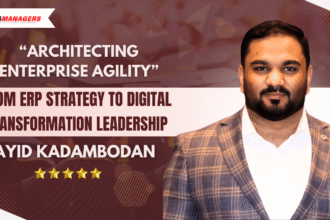Crises are the ultimate stress test for leadership. Whether it’s a global pandemic, economic recession, supply chain disruption, cybersecurity breach, or geopolitical uncertainty—how an organization’s leaders respond in those critical moments defines not just survival, but long-term credibility and success. In these turbulent times, CXOs are expected not only to manage risk but to lead with resilience, clarity, and purpose.
At the heart of this leadership lies the ability to make tough decisions quickly, communicate transparently, prioritize people, and evolve strategies on the fly. Through global insights and shared experiences, this CXO roundtable explores how top executives are navigating crisis by embedding resilience into operations and aligning their decisions with a greater purpose.
Leadership Begins with Clarity and Calm
In the initial moments of any crisis, uncertainty fuels fear. The first role of any CXO is to bring stability to the storm. For CEOs, this often means providing a clear direction and maintaining composure when emotions run high.
“A crisis magnifies leadership,” says a global CEO in the logistics sector. “You can’t control the event, but you can control how you respond—and how you guide others through it.”
Clear, consistent communication becomes a critical tool. Employees, investors, and customers look to the C-suite for not only solutions but reassurance. Successful CEOs are those who prioritize transparency over perfection, acknowledge unknowns, and engage stakeholders with empathy and realism.
CIOs & CTOs: Ensuring Continuity Through Technology
Crises have proven that digital infrastructure is no longer optional—it’s essential. CIOs and CTOs sit at the frontline, ensuring business continuity, cybersecurity, and remote accessibility.
During the COVID-19 pandemic, organizations with robust cloud systems, collaboration tools, and cybersecurity protocols pivoted more swiftly. CIOs who had invested early in digital transformation found themselves well-prepared to scale operations virtually.
“The ability to deploy secure remote systems in under 48 hours kept our global teams functional,” shared a CIO at a multinational consulting firm. “The crisis validated our long-term tech roadmap—and accelerated it by five years.”
Technology leaders must also safeguard data integrity, implement rapid response protocols, and collaborate with business units to innovate under pressure.
CFOs: Reassessing Priorities in Real-Time
For CFOs, crises are moments of heightened responsibility. Financial leaders must quickly reassess liquidity, manage cost structures, secure funding, and revise forecasts—often daily. But more importantly, they must balance fiscal prudence with long-term strategic thinking.
“Cost-cutting is the easy part,” notes one CFO. “The challenge is protecting the core of your business while keeping your people and partners engaged.”
Modern CFOs are taking more agile approaches to budget planning and cash flow management, utilizing real-time analytics to inform rapid decisions. They also play a key role in scenario modeling—helping leadership visualize best- and worst-case outcomes.
CMOs: Empathy-Driven Communication
In a crisis, every message matters. CMOs must rethink how they engage customers, partners, and the public. Marketing becomes less about selling and more about listening, empathizing, and reinforcing brand purpose.
Tone, timing, and authenticity define effective communication in times of distress. “Marketing during a crisis is about connection, not conversion,” says the CMO of a leading consumer brand. “We stopped campaigns, rewrote content, and focused entirely on how we could be useful to our customers.”
Purpose-driven brands that demonstrated social responsibility, supported frontline workers, or addressed customer pain points during crises built long-term trust and loyalty.
CHROs: Prioritizing People and Well-Being
For Chief Human Resource Officers, a crisis is a human issue first. They must address workforce safety, morale, and mental health—while supporting leaders in making tough staffing decisions when necessary.
CHROs became the linchpins during recent global crises—building remote work policies, supporting employee well-being, and ensuring equity across decentralized teams.
“People-first leadership isn’t optional anymore,” says a CHRO from a Fortune 500 firm. “Flexibility, empathy, and mental health resources are part of our long-term strategy now, not just short-term reactions.”
Companies with strong employee engagement and inclusive cultures proved more resilient, adapting faster and recovering sooner.

Collaboration Over Hierarchy
Crises often flatten traditional hierarchies. At the CXO level, success comes from close collaboration, not command-and-control structures. Cross-functional war rooms, daily huddles, and scenario planning sessions become the norm.
“The silos broke down quickly,” one COO observed. “Suddenly, the CFO was in every supply chain meeting. The CIO was talking to marketing daily. Crisis forced us to unite behind one mission.”
This spirit of collaboration extends beyond the organization. CXOs are increasingly partnering with governments, NGOs, and industry peers to address systemic challenges like supply shortages, misinformation, or health emergencies.
Resilience Is Built Before the Crisis
True resilience isn’t built during a crisis—it’s embedded long before. Organizations that thrive in crisis are those that invest in:
- Robust risk management frameworks
- Agile decision-making structures
- Cross-trained teams and decentralized leadership
- Strong stakeholder trust
- Digital infrastructure and automation
Purpose plays a central role. Companies with a clearly defined mission and set of values find it easier to align decisions, sustain morale, and make ethical trade-offs.
Looking Forward: Purpose as a Competitive Advantage
As we emerge from a period marked by back-to-back disruptions, one truth stands tall: Purpose sustains resilience. CXOs must lead not just to protect revenue but to serve a broader mission—be it social impact, environmental responsibility, or customer empowerment.
Crisis reveals character. The companies that led with empathy, acted with urgency, and stayed true to their values have emerged stronger, more trusted, and more agile.
Going forward, the most effective CXOs will be those who internalize these lessons, embed resilience in culture and strategy, and turn purpose from a poster on the wall into a competitive edge.
Conclusion
Crisis leadership demands more than operational skill—it calls for emotional intelligence, strategic agility, and shared purpose. CXOs who rise to the occasion not only steer their organizations through storms but emerge as stronger, more inspiring leaders.













